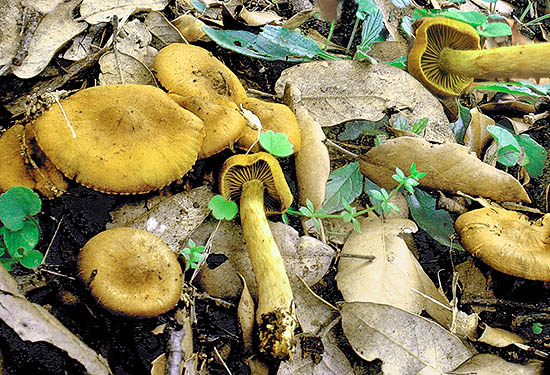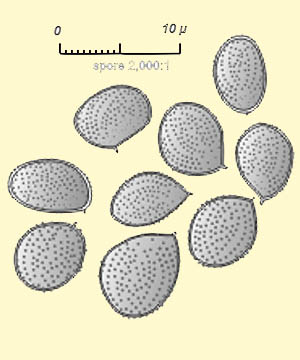Text © Bruno Gasparini

English translation by Mario Beltramini

Little known fungus with suspect edibility © Bruno Gasparini
Family: Cortinariaceae.
Genus: Cortinarius.
Subgenus: Dermocybe.
Section: Olivaceofusci.
Cortinarius olivaceofuscus Kűhner, 1955.
On collection, the section is characterised by the olivaceous tinges and, chemically by the presence of anthraquinonic pigments with the lowest degree of oxidation. (flavomannin 6’6 dimetilether and endocrocin).
This and the bi-hemispherical presence with a restrict number of species, suggests a relict group of very ancient origin, possibly precedent to all other Cortinarius (They appear, according to description, close to subgenus Icterinula exclusive of the Southern hemispbere).
Basionym: Kühner, 1955. Bull. Mens. Soc. Linn. Lyon. P 39-40.
Synonyms: Dermocybe olivaceofusca (Kühner R.) Quadraccia 1985 Cortinarius (Dermocybe) carpineti (Moser) Garnier G. 1991.
Names missapplied : Cortinarius (Dermocybe) malicorius ss. Pearson 1952, sec. Orton 1958, Cort. : 132, 136, 143 Cortinarius (Dermocybe) croceus ss. Schaeffer, sec. Bresadola (cf. Moser 1973, Bull. Suisse) Cortinarius (Dermocybe) schaefferi Bresadola 1930, Tab. 648.
Habit: flammuloid, reminiscent of Cortinarius croceus, but with olivaceous hues.

The spores © Bruno Gasparini
Cap: 20-40 (50) mm bell-shaped, then more plane, slightly umbonate on the disc, frail, cuticle fibrillose, with small scales olivaceous, later on russet and eventually brown, or lemon yellow, on a yellow-olive background, with a darker (brownish) disc
Hymenium: gills close, slightly undulated, occasionally serrate, annexed-emarginate, yellow-olivaceous
Stipe: sometime shorter, sometimes longer than the cap diameter, 35-40-60 mm x 5 mm, occasionally a bit twisted, cylindrical base slightly swollen, sulphur yellow on top, olivaceous at the base, with the debris of a veil originally yellow-olive, later greyish a finally brown; cortina evanescent.
Contest: almost inexistent in the cap margin, fibrous then fistulous in the central axis yellow-green olive. Smell reminiscent of tobacco containers, or fruity with an earthy background. Taste slightly bitter.
Edibility: unknown, but to be considered suspect.
Chemical reactions: on cap and context alkalis (ammonia included) ink red, then dark blood red. In alcohol an olive green solution leaks out.
Spores: almost quadrangular sideways, subamygdaliform or oval, medium-small, 6,5-8,4 x 4,3-5,5 µm, finely punctuated.
Habitat: under broadleaf particularly in warm climate oaks, holm-oaks (Quercus ilex), horn-beams (Carpinus orientalis or Ostrya carpinifolia).
Notes
Typical Dermocybe with flammuloid habit and olivaceous colours. It may be confused with Cortinarius croceus which grows, though, in conifer woods. Though its edibility has not been texted, it is advised against eating small colourful cortinaires. This species can be rather variable with dark olive or citrus hues and spores 6,5-8 x 4-5 or smaller (5,4-6,7 x 4-4,8) and broader. Exams carried out through the DNA found a complex of at least 2 unseparated species.
→ For general notions about Fungi please click here.
→ To appreciate the biodiversity of MUSHROOMS please click here.
